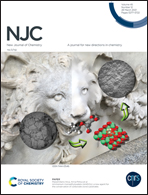Growth of bimodal NiCo2O4·MnO2 nanorods in situ on carbon fiber paper synergistically affects their electrochemical properties†
Abstract
Bimodal NiCo2O4·MnO2 (NCM) nanorods were grown on carbon fiber paper (CFP) using a hydrothermal process. The structural and morphological studies were performed via powder X-ray diffraction and field-emission scanning electron microscopy, respectively. The aspect ratio of the developed electrode significantly improved up to a threshold concentration of manganese in the Ni/Co binary oxide, and thereafter decreased. The capacitive performance and electrochemical parameters of the developed NCM nanorods were analyzed using cyclic voltammetry, galvanostatic charge–discharge, and impedance spectroscopy. The maximum specific capacitance of the developed NCM nanorods was found to be 2575 F g−1 (305 mA h g−1) at a current density of 5 A g−1. Additionally, the excellent cyclic retention of nearly 92.5% was achieved for the NCM nanocomposite even after 5000 cycles. Also, the response time (τo) calculated from the Bode plot was found to be ∼22 s, which validated the fast charging of the developed electrode material. Furthermore, an asymmetric solid-state supercapacitor (ASC) device was successfully assembled utilizing NCM (1 : 2 : 2) nanorods and activated carbon as positive and negative electrodes, respectively. The developed device achieved a capacitance of 130 F g−1 (176.1 mA h g−1) with an energy density and power density of 138 W h kg−1 and 722 W kg−1, respectively, which could illuminate an LED bulb (1.8 V) for 50 min.



 Please wait while we load your content...
Please wait while we load your content...